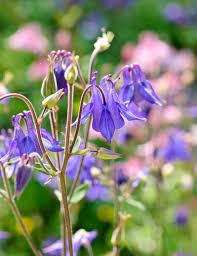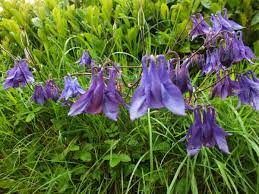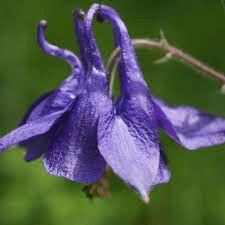Aquilegia vulgaris, commonly known as Columbine, is a herbaceous perennial plant belonging to the Ranunculaceae family. Native to Europe, Columbine is known for its attractive and distinctive flowers, making it a popular choice in gardens.
Key features of Aquilegia vulgaris include its finely divided, fern-like foliage and unique spurred flowers. The flowers have five distinctive petal-like sepals, which are often bi-colored, creating an interesting and visually appealing effect. The characteristic spurs behind the petals give Columbine its unique appearance. The flowers come in a range of colors, including various shades of blue, purple, pink, white, and yellow.
Columbine is a versatile plant that can thrive in various garden settings, from woodland gardens to perennial borders. It prefers well-drained soil and can tolerate partial shade, although it also grows well in full sun. The plant typically blooms in late spring to early summer, attracting pollinators like bees and hummingbirds.
One interesting aspect of Columbine is its ability to self-seed, producing offspring that may exhibit different flower colors and variations. This self-seeding nature contributes to the plant’s adaptability and can result in a diverse and charming display in the garden.
While Aquilegia vulgaris is generally appreciated for its ornamental value, it’s essential to note that all parts of the plant contain substances that can be toxic if ingested. Therefore, caution should be exercised, especially if there are children or pets around. Additionally, proper care and cultivation practices can help maintain and enjoy the beauty of Columbine in garden landscapes.
The Botanical Description of Aquilegia vulgaris
1. Plant Structure: Aquilegia vulgaris, commonly known as Columbine, is a perennial herbaceous plant characterized by its tall, slender stems and distinctive foliage.
2. Leaves: The leaves of Aquilegia vulgaris are compound and fern-like, with a delicate appearance. They are divided into three lobes, giving the plant an airy and graceful quality.
3. Flowers: The flowers are a highlight, featuring spurred petals that resemble a cluster of doves. The colours vary from shades of blue, purple, pink, and white, creating a visually appealing display.
4. Height: This plant typically reaches a height of 2 to 3 feet, making it an attractive addition to gardens and landscapes.
5. Root System: Aquilegia vulgaris has a fibrous root system, aiding in its resilience and ability to thrive in various soil types.
6. Blooming Season: The flowering season extends from late spring to early summer, adding a burst of color to the surroundings.
7. Adaptability: Known for its adaptability, Aquilegia vulgaris can be found in a range of environments, from woodlands to meadows, showcasing its versatility.
8. Seed Pods: After flowering, distinctive seed pods develop, resembling small lanterns. These pods contribute to the plant’s ornamental appeal.
9. Sunlight Requirements: Columbine prefers partial shade but can tolerate full sun in cooler climates.
10. Fragrance: While not strongly scented, some varieties of Aquilegia vulgaris may emit a subtle, pleasant fragrance.
11. Foliage Texture: The foliage texture is fine and feathery, creating a soft contrast to the more prominent flowers.
12. Cultivars: Numerous cultivars of Aquilegia vulgaris exist, showcasing variations in flower color, size, and leaf form, providing options for gardeners.
The Geographic Distribution of Aquilegia vulgaris

1. Native Regions: Aquilegia vulgaris is native to Europe and can be found in diverse habitats, including meadows, woodlands, and rocky slopes.
2. Naturalized Areas: Over time, Columbine has naturalized in various regions, including North America, where it thrives in gardens and has established itself in the wild.
3. Altitude Range: The plant exhibits adaptability to different altitudes, from lowland areas to mountainous regions, showcasing its ecological flexibility.
4. Climate Preferences: Aquilegia vulgaris prefers temperate climates but can tolerate a range of conditions, making it suitable for cultivation in different parts of the world.
5. Soil Types: It can grow in various soil types, as long as the soil is well-draining. The plant’s adaptability contributes to its wide distribution.
6. Human Cultivation: Columbine’s popularity in gardens and landscaping has contributed to its global presence, as it is often intentionally cultivated by enthusiasts.
7. Invasive Potential: While not typically considered invasive, under certain conditions, Aquilegia vulgaris can self-seed and spread, establishing itself in new areas.
8. Gardening Zones: The plant is hardy in USDA zones 3-8, indicating its ability to withstand a range of temperatures and climates.
9. Habitat Diversity: Aquilegia vulgaris can thrive in diverse habitats, from sunny meadows to shaded woodlands, showcasing its ecological adaptability.
10. Global Popularity: Due to its aesthetic appeal, Aquilegia vulgaris is cultivated and appreciated in gardens worldwide, further extending its geographic presence.
The Chemical Composition of Aquilegia vulgaris
1. Alkaloids: Aquilegia vulgaris contains alkaloids, including berberine and magnoflorine, which contribute to its medicinal properties.
2. Flavonoids: Rich in flavonoids, the plant exhibits antioxidant properties, protecting cells from oxidative stress.
3. Tannins: Tannins are present in Aquilegia vulgaris, contributing to its astringent qualities and potential health benefits.
4. Saponins: The plant contains saponins, which may have antimicrobial properties and play a role in traditional medicinal uses.
5. Terpenoids: Aquilegia vulgaris contains terpenoids, compounds known for their diverse biological activities, adding to the plant’s pharmacological potential.
6. Essential Oils: Some varieties of Aquilegia vulgaris may produce essential oils with varying compositions, contributing to the plant’s fragrance and potential therapeutic effects.
7. Phenolic Compounds: Phenolic compounds, such as quercetin and kaempferol, are present in Aquilegia vulgaris, contributing to its anti-inflammatory properties.
8. Vitamins: The plant may contain vitamins, including vitamin C, which contribute to its overall nutritional profile.
9. Minerals: Aquilegia vulgaris may accumulate minerals from the soil, adding to its nutritional content.
10. Glycosides: Glycosides, including cardiac glycosides, are found in Aquilegia vulgaris, potentially influencing its cardiac effects.
11. Lignans: Some varieties of Aquilegia vulgaris contain lignans, compounds with antioxidant properties and potential health benefits.
12. Carotenoids: Carotenoids, responsible for the plant’s colorful pigments, are present in Aquilegia vulgaris, contributing to its visual appeal.
Read Also: Anemone Flowers – All you need to know
The Medicinal Health Benefits Of Aquilegia vulgaris (Columbine)

1. Anti-Inflammatory Properties: Aquilegia vulgaris has demonstrated anti-inflammatory effects, making it potentially beneficial for conditions involving inflammation.
2. Antioxidant Effects: The plant’s rich flavonoid and phenolic content contribute to its antioxidant properties, protecting cells from oxidative damage.
3. Respiratory Health: Traditional uses suggest that Aquilegia vulgaris may support respiratory health, potentially easing symptoms of respiratory conditions.
4. Digestive Aid: Some cultures have used Aquilegia vulgaris to address digestive issues, attributing its benefits to certain chemical compounds present in the plant.
5. Skin Health: External applications of Aquilegia vulgaris, such as in ointments or salves, are believed to promote skin health and alleviate certain skin conditions.
6. Cardiovascular Support: The presence of cardiac glycosides in Aquilegia vulgaris may contribute to its potential cardiovascular benefits.
7. Immune System Modulation: Aquilegia vulgaris may have immune-modulating properties, potentially supporting the body’s defense mechanisms.
8. Pain Relief: Traditional uses include the use of Aquilegia vulgaris for pain relief, with potential applications in managing mild to moderate pain.
9. Diuretic Effects: The plant’s diuretic properties may aid in promoting kidney health and maintaining fluid balance in the body.
10. Menstrual Support: Some traditional uses involve Aquilegia vulgaris for women’s health, with applications in supporting menstrual well-being.
11. Stress Reduction: Certain compounds in Aquilegia vulgaris may have calming effects, contributing to its traditional use in stress management.
12. Anti-Microbial Activity: The presence of saponins and
The Methods of Usage to Achieve the Provided Health Benefits Of Aqu ilegia vulgaris (Columbine)
1. Herbal Infusions: Prepare herbal infusions by steeping Aquilegia vulgaris leaves or flowers in hot water. This method can promote respiratory health and provide antioxidant benefits.
2. Topical Applications: Create ointments or salves using Aquilegia vulgaris extracts for skin health. Ensure proper dilution to avoid skin irritation.
3. Tinctures: Tinctures made from the plant’s extracts can be used to harness its medicinal properties. Follow recommended dosage guidelines.
4. Culinary Use: In some cultures, Aquilegia vulgaris is used in culinary dishes. However, caution is advised, as not all parts of the plant may be edible.
5. Aromatherapy: Utilize essential oils extracted from Aquilegia vulgaris for aromatherapy purposes. The calming effects can contribute to stress reduction.
6. Capsules or Tablets: For a convenient and measured intake, consider encapsulating Aquilegia vulgaris extracts into capsules or tablets.
7. Poultices: Apply poultices made from mashed or crushed parts of the plant to address localized pain or skin conditions.
8. Inhalation: Inhaling the fragrance of Aquilegia vulgaris through essential oil diffusion or steam inhalation may offer respiratory benefits.
9. Tea Blends: Combine Aquilegia vulgaris with other complementary herbs to create tea blends that cater to specific health needs.
10. Compresses: Use Aquilegia vulgaris-infused compresses for targeted relief, especially for joint or muscle discomfort.
The Side Effects Of Using Aquilegia vulgaris Medicinal Plant
1. Allergic Reactions: Some individuals may experience allergic reactions to Aquilegia vulgaris, leading to skin irritation or respiratory symptoms.
2. Gastrointestinal Distress: Excessive consumption may lead to gastrointestinal issues such as nausea, vomiting, or diarrhea.
3. Photosensitivity: Certain compounds in Aquilegia vulgaris may increase sensitivity to sunlight, leading to skin reactions upon sun exposure.
4. Toxicity Concerns: Ingesting large quantities of certain parts of the plant may result in toxicity, affecting the liver or other organs.
5. Interactions with Medications: Consultation with a healthcare professional is crucial, as Aquilegia vulgaris may interact with certain medications.
6. Pregnancy and Breastfeeding: Pregnant or breastfeeding individuals should avoid using Aquilegia vulgaris due to potential unknown effects on fetal development or nursing infants.
7. Not Suitable for Children: The plant may not be suitable for use in children, and caution is advised in pediatric healthcare.
8. Respiratory Irritation: Inhalation of concentrated essential oils may cause respiratory irritation in some individuals.
9. Blood Pressure Effects: Due to potential cardiovascular effects, individuals with existing blood pressure issues should use Aquilegia vulgaris with caution.
10. Excessive Diuresis: The diuretic effects of Aquilegia vulgaris may lead to dehydration if not used judiciously.
11. Central Nervous System Effects: Some individuals may experience dizziness or sedation, especially when using Aquilegia vulgaris in large quantities.
12. Not a Substitute for Professional Medical Advice: It is essential to note that Aquilegia vulgaris should not replace professional medical advice, diagnosis, or treatment.
Read Also: 19 Medicinal Health Benefits Of Fenugreek (Trigonella foenum-graecum)
The Scientific Research and Studies of Aquilegia vulgaris

1. Anti-Inflammatory Effects: Scientific studies have explored the anti-inflammatory properties of Aquilegia vulgaris, suggesting potential applications in inflammatory conditions.
2. Antioxidant Activity: Research indicates the antioxidant activity of the plant, attributing its effects to specific chemical compounds present in the plant.
3. Respiratory Benefits: Studies have investigated the respiratory benefits of Aquilegia vulgaris, providing insights into its potential role in supporting lung health.
4. Cardiovascular Effects: Scientific inquiries have explored the cardiovascular effects of Aquilegia vulgaris, focusing on its impact on heart health.
5. Immunomodulatory Properties: Research suggests that Aquilegia vulgaris may modulate the immune system, potentially enhancing the body’s defense mechanisms.
6. Pain Management: Studies have delved into the analgesic properties of Aquilegia vulgaris, shedding light on its potential role in pain management.
7. Antimicrobial Activity: Scientific investigations have explored the antimicrobial activity of Aquilegia vulgaris, indicating potential applications in addressing microbial infections.
8. Safety and Toxicology: Research on the safety and toxicology of Aquilegia vulgaris is essential for understanding its potential risks and benefits in medicinal use.
The Safety Precautions and Recommendations In Using Aquilegia vulgaris Medicinal Plant
1. Consultation with Healthcare Professionals: Before using Aquilegia vulgaris for medicinal purposes, it is crucial to consult with healthcare professionals, especially for individuals with pre-existing medical conditions.
2. Dosage Guidance: Follow recommended dosage guidelines provided by reputable sources or healthcare practitioners to avoid adverse effects.
3. Allergy Testing: Conduct allergy testing before topical application or ingestion to identify potential allergic reactions.
4. Sun Protection: Due to potential photosensitivity, users should apply sun protection measures, such as sunscreen, when using Aquilegia vulgaris.
5. Avoid During Pregnancy and Breastfeeding: Pregnant and breastfeeding individuals should avoid using Aquilegia vulgaris due to potential risks to fetal development or nursing infants.
6. Monitor Blood Pressure: Individuals with existing blood pressure issues should monitor their blood pressure regularly when using Aquilegia vulgaris.
7. Caution in Children: The use of Aquilegia vulgaris in children should be approached with caution, and professional advice is recommended.
8. Controlled Essential Oil Use: If using essential oils, exercise caution to prevent respiratory irritation, and follow proper dilution guidelines.
9. Limit Diuretic Use: Use Aquilegia vulgaris diuretic properties judiciously to prevent excessive diuresis and dehydration.
10. Discontinue in Case of Adverse Reactions: If adverse reactions occur, such as skin irritation, gastrointestinal distress, or dizziness, discontinue use and seek medical attention.
11. Storage and Handling: Properly store and handle Aquilegia vulgaris products to maintain their efficacy and prevent contamination.
12. Education and Awareness: Users should educate themselves about the plant, its potential effects, and safety considerations before use.
FAQs About Aquilegia vulgaris Medicinal Plant
1. Is Aquilegia vulgaris Safe for Daily Use?
Aquilegia vulgaris is generally safe for daily use when consumed or applied in moderation. However, individual reactions may vary, and it’s advisable to start with small amounts and monitor for adverse effects.
2. Can Aquilegia vulgaris Be Used During Pregnancy?
Pregnant individuals should avoid using Aquilegia vulgaris due to potential risks to fetal development. Consultation with a healthcare professional is crucial for personalized advice.
3. How Should Aquilegia vulgaris Essential Oil Be Diluted for Topical Use?
For topical applications, essential oils derived from Aquilegia vulgaris should be diluted in a carrier oil following recommended ratios (e.g., 2-3 drops per teaspoon of carrier oil) to prevent skin irritation. Conduct a patch test before widespread use to ensure compatibility.
4. What Parts of Aquilegia vulgaris Are Edible?
While some cultures historically used certain parts of Aquilegia vulgaris in culinary practices, caution is advised. Not all parts of the plant may be edible, and consumption should be approached with knowledge and awareness of potential toxicity.
5. Can Aquilegia vulgaris Help with Respiratory Issues?
Aquilegia vulgaris has been traditionally used for respiratory health. Scientific studies suggest potential benefits, including anti-inflammatory effects, which may contribute to alleviating symptoms of respiratory conditions. However, it is not a substitute for professional medical advice.
6. Are There Any Interactions Between Aquilegia vulgaris and Medications?
Individuals taking medications should consult with healthcare professionals before using Aquilegia vulgaris, as it may interact with certain drugs. This precaution is particularly important for those on medications affecting the cardiovascular system or with potential contraindications.
7. How Can Aquilegia vulgaris Be Incorporated into Culinary Dishes?
While some cultures historically used Aquilegia vulgaris in culinary practices, caution is essential. The edible parts, if any, should be properly identified, and their culinary use should align with cultural practices and safety guidelines.
8. Can Aquilegia vulgaris Be Used for Stress Management?
Certain compounds in Aquilegia vulgaris may have calming effects, making it traditionally used for stress management. However, individual responses may vary, and it should not replace established stress management practices or professional advice.
9. Are There Different Varieties of Aquilegia vulgaris with Unique Benefits?
Yes, Aquilegia vulgaris has numerous cultivars, each with variations in flower color, size, and leaf form. While these varieties share common characteristics, their specific chemical compositions may differ, potentially influencing their benefits.
10. Is Aquilegia vulgaris Suitable for Children?
Caution is advised when considering the use of Aquilegia vulgaris in children. Professional advice should be sought, and the plant’s safety in pediatric healthcare should be thoroughly evaluated before use.
11. Can Aquilegia vulgaris Essential Oils Be Used in Aromatherapy Diffusers?
Yes, essential oils extracted from Aquilegia vulgaris can be used in aromatherapy diffusers. The calming effects of the fragrance may contribute to a soothing atmosphere, promoting relaxation.
12. How Can Aquilegia vulgaris Benefit Skin Health?
External applications, such as ointments or salves made from Aquilegia vulgaris extracts, are believed to promote skin health. The plant’s anti-inflammatory and antioxidant properties may contribute to its potential benefits for the skin.
13. Are There Any Known Cases of Aquilegia vulgaris Toxicity?
While Aquilegia vulgaris is not typically considered highly toxic, ingestion of large quantities or misuse may lead to toxicity. Cases of toxicity are rare, but users should exercise caution and follow recommended guidelines.
14. Can Aquilegia vulgaris Be Used Alongside Other Medicinal Herbs?
Combining Aquilegia vulgaris with other medicinal herbs can be done, but users should be aware of potential interactions and effects. Consultation with a healthcare professional or herbalist is recommended for personalized advice.
15. How Long Does It Take to Experience the Medicinal Effects of Aquilegia vulgaris?
The onset of medicinal effects may vary depending on the method of usage and individual responses. Immediate effects, such as skin soothing or respiratory relief, may be noticed, while long-term benefits may require consistent use over an extended period.
16. Can Aquilegia vulgaris Be Grown Indoors?
While Aquilegia vulgaris is typically an outdoor plant, it may be possible to grow certain varieties indoors. Adequate sunlight, well-draining soil, and proper care are essential for successful indoor cultivation.
17. Can Aquilegia vulgaris Be Used for Pain Management?
Traditionally, Aquilegia vulgaris has been used for pain relief. Scientific studies have explored its potential analgesic properties, making it a consideration for mild to moderate pain management.
18. Can Aquilegia vulgaris Be Used for Allergies?
While Aquilegia vulgaris has anti-inflammatory properties, its use for allergies is not well-established. Individuals with allergies should exercise caution and seek advice from healthcare professionals for appropriate treatments.
Read Also: All You Need to Know About Cosmos Flower
